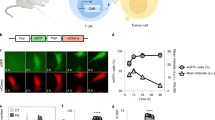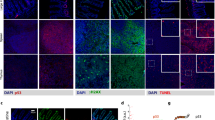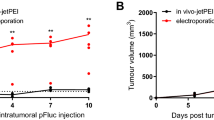Abstract
Ionising radiation induces the expression of a number of radiation-responsive genes and there is current interest in exploiting this to regulate the expression of exogenous therapeutic genes in gene therapy strategies for cancer. However, the radiation-responsive promoters used in these approaches are often associated with low and transient levels of therapeutic gene expression. We describe here a novel radiation-triggered molecular switching device based on promoter elements from the radiation-responsive Egr-1 gene and the cre-LoxP site-specific recombination system of the P1 bacteriophage. Using this system, a single, minimally toxic dose of radiation induced cre-mediated excision of a lox-P flanked stop cassette in a silenced expression vector and this resulted in amplified levels of CMV-promoter-driven expression of the exogenous tumour-sensitising gene, HSV-tk. This strategy could be used in combination with targeted delivery and tumour-specific promoters to elicit the tumour-targeted and prolonged expression of a variety of tumour-sensitising genes and provide an unprecedented level of control and tumour selectivity.
This is a preview of subscription content, access via your institution
Access options
Subscribe to this journal
Receive 12 print issues and online access
$259.00 per year
only $21.58 per issue
Buy this article
- Purchase on Springer Link
- Instant access to full article PDF
Prices may be subject to local taxes which are calculated during checkout


Similar content being viewed by others
References
Weichselbaum RR, Hallahan DE, Fuks Z, Kufe DW . Radiation induction of immediate early genes: effectors of the radiation stress response Int J Radiat Oncol Biol Phys 1994 30: 229–234
Weichselbaum RR et al. Gene therapy targeted by radiation preferentially radiosensitizes tumor cells Cancer Res 1994 54: 4266–4269
Dachs GU, Dougherty GJ, Stratford IJ, Chaplin DJ . Targeting gene therapy to cancer: a review Oncol Res 1997 9: 313–325
Weichselbaum RR, Kufe D . Gene therapy of cancer Lancet 1997 349: SII10–SII12
Hallahan DE, Weichselbaum R . Role of gene therapy in radiation oncology Cancer Treat Res 1998 93: 153–167
Hallahan DE et al. Spatial and temporal control of gene therapy using ionizing radiation Nature Med 1995 1: 786–791
Jahroudi N, Ardekani AM, Greenberger JS . Ionizing irradiation increases transcription of the von Willebrand factor gene in endothelial cells Blood 1996 88: 3801–3814
Joki T, Nakamura M, Ohno T . Activation of the radiosensitive EGR-1 promoter induces expression of the herpes simplex virus thymidine kinase gene and sensitivity of human glioma cells to ganciclovir Hum Gene Ther 1995 6: 1507–1513
Takahashi T, Namiki Y, Ohno T . Induction of the suicide HSV TK gene by activation of the Egr 1 promoter with radioisotopes Hum Gene Ther 1997 8: 827–833
Datta R et al. Ionizing radiation activates transcription of the EGR1 gene via CArG elements Proc Natl Acad Sci USA 1992 89: 10149–10153
Datta R et al. Reactive oxygen intermediates target CC(A/T)6GG sequences to mediate activation of the early growth response 1 transcription factor gene by ionizing radiation Proc Natl Acad Sci USA 1993 90: 2419–2422
Marples B et al. Development of synthetic promoters for radiation-mediated gene therapy Gene Therapy 2000 7: 511–517
Sternberg N, Hamilton D, Hoess R . Bacteriophage P1 site-specific recombination. II. Recombination between loxP and the bacterial chromosome J Mol Biol 1981 150: 487–507
Sauer B, Henderson N . Cre-stimulated recombination at loxP-containing DNA sequences placed into the mammalian genome Nucleic Acids Res 1989 17: 147–161
Kilby NJ, Snaith MR, Murray JA . Site-specific recombinases: tools for genome engineering Trends Genet 1993 9: 413–421
Anton M, Graham FL . Site-specific recombination mediated by an adenovirus vector expressing the Cre recombinase protein: a molecular switch for control of gene expression J Virol 1995 69: 4600–4606
Guo Z et al. Efficient and sustained transgene expression in mature rat oligodendrocytes in primary culture J Neurosci Res 1996 43: 32–41
Bartlett RJ et al. Long-term expression of a fluorescent reporter gene via direct injection of plasmid vector into mouse skeletal muscle: comparison of human creatine kinase and CMV promoter expression levels in vivo Cell Transplant 1996 5: 411–419
Ropp JD et al. Aequorea green fluorescent protein analysis by flow cytometry Cytometry 1995 21: 309–317
Lybarger L, Dempsey D, Franek KJ, Chervenak R . Rapid generation and flow cytometric analysis of stable GFP-expressing cells Cytometry 1996 25: 211–220
Wagner MJ, Sharp JA, Summers WC . Nucleotide sequence of the thymidine kinase gene of herpes simplex virus type 1 Proc Natl Acad Sci USA 1981 78: 1441–1445
Kim JH, Kim SH, Brown SL, Freytag SO . Selective enhancement by an antiviral agent of the radiation-induced cell killing of human glioma cells transduced with HSV-tk gene Cancer Res 1994 54: 6053–6056
Manome Y et al. Transgene expression in malignant glioma using a replication-defective adenoviral vector containing the Egr-1 promoter: activation by ionizing radiation or uptake of radioactive iododeoxyuridine Hum Gene Ther 1998 9: 1409–1417
Elshami AA et al. Gap junctions play a role in the ‘bystander effect’ of the herpes simplex virus thymidine kinase/ganciclovir system in vitro Gene Therapy 1996 3: 85–92
Denning C, Pitts JD . Bystander effects of different enzyme-prodrug systems for cancer gene therapy depend on different pathways for intercellular transfer of toxic metabolites, a factor that will govern clinical choice of appropriate regimes Hum Gene Ther 1997 8: 1825–1835
Duflot-Dancer A et al. Long-term connexin-mediated bystander effect in highly tumorigenic human cells in vivo in herpes simplex virus thymidine kinase/ganciclovir gene therapy Gene Therapy 1998 5: 1372–1378
Kianmanesh AR et al. ‘Distant’ bystander effect of suicide gene therapy: regression of nontransduced tumors together with a distant transduced tumor Hum Gene Ther 1997 8: 1807–1814
Misawa T et al. Development of systemic immunologic responses against hepatic metastases during gene therapy for peritoneal carcinomatosis with retroviral HS-tk and ganciclovir J Gastrointest Surg 1997 1: 527–533
Wilson KM et al. HSV-tk gene therapy in head and neck squamous cell carcinoma. Enhancement by the local and distant bystander effect Arch Otolaryngol Head Neck Surg 1996 122: 746–749
Elliott G, O'Hare P . Intercellular trafficking of VP22-GFP fusion proteins Gene Therapy 1999 6: 149–151
Kanegai Y et al. Efficient gene activation in mammalian cells by using recombinant adenovirus expressing site-specific Cre recombinase Nucleic Acids Res 1995 23: 3816–3821
Sakai K, Mitani K, Miyazaki J . Efficient regulation of gene expression by adenovirus vector-mediated delivery of the CRE recombinase Biochem Biophys Res Comm 1995 217: 393–401
Lasko M et al. Targeted oncogene activation by site-specific recombination in transgenic mice Proc Natl Acad Sci USA 1992 98: 6232–6236
Sato Y et al. Enhanced and specific gene expression via tissue-specific production of Cre recombinase using adenovirus vector Biochem Biophys Res Comm 1998 244: 455–462
Anderson WF . Human gene therapy Nature 1998 392: 25–30
Mullen CA, Petropoulos D, Lowe RM . Treatment of microscopic pulmonary metastases with recombinant autologous tumor vaccine expressing interleukin 6 and Escherichia coli cytosine deaminase suicide genes Cancer Res 1996 56: 1361–1366
Hart IR . Tissue specific promoters in targeting systemically delivered gene therapy Semin Oncol 1996 23: 154–158
Prince HM . Gene transfer: a review of methods and applications Pathology 1998 30: 335–347
Acknowledgements
BM and SDS were equal contributors to this work. We thank Dr Steve Roberts for statistical analysis. The studies were supported by the Cancer Research Campaign. SDS was supported by the Christie Hospital Endowment Fund, BM was supported by the Friends of Rosie Children's Cancer Research Fund. MJE is a Cancer Research Campaign Life Fellow.
Author information
Authors and Affiliations
Rights and permissions
About this article
Cite this article
Scott, S., Marples, B., Hendry, J. et al. A radiation-controlled molecular switch for use in gene therapy of cancer. Gene Ther 7, 1121–1125 (2000). https://doi.org/10.1038/sj.gt.3301223
Received:
Accepted:
Published:
Issue Date:
DOI: https://doi.org/10.1038/sj.gt.3301223
Keywords
This article is cited by
-
Demonstration of Tightly Radiation-Controlled Molecular Switch Based on CArG Repeats by In Vivo Molecular Imaging
Molecular Imaging and Biology (2015)
-
Evaluation of p21 promoter for interleukin 12 radiation induced transcriptional targeting in a mouse tumor model
Molecular Cancer (2013)
-
The radiation-inducible pE9 promoter driving inducible nitric oxide synthase radiosensitizes hypoxic tumour cells to radiation
Gene Therapy (2008)
-
Hypoxia- and radiation-activated Cre/loxP ‘molecular switch’ vectors for gene therapy of cancer
Gene Therapy (2006)
-
Plasmid Engineering for Controlled and Sustained Gene Expression for Nonviral Gene Therapy
Pharmaceutical Research (2006)



